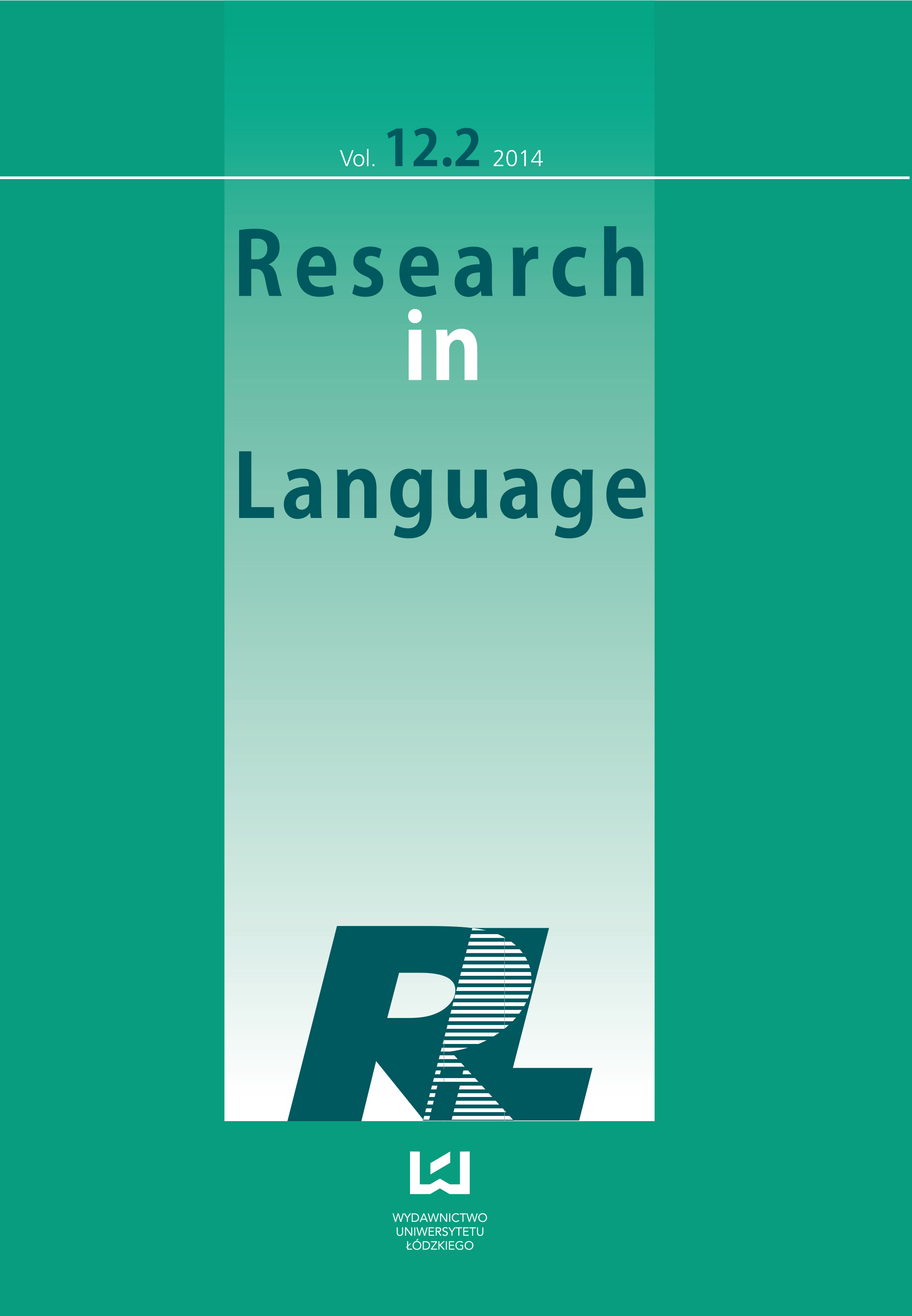Assimilation of Voicing in Czech Speakers of English: The Effect of the Degree of Accentedness
DOI:
https://doi.org/10.2478/rela-2014-0007Keywords:
foreign accent, voicing, assimilation of voicing, Czech, EnglishAbstract
Czech and English are languages which differ with respect to the implementation of voicing. Unlike in English, there is a considerable agreement between phonological (systemic) and phonetic (actual) voicing in Czech, and, more importantly, the two languages have different strategies for the assimilation of voicing across the word boundary. The present study investigates the voicing in word-final obstruents in Czech speakers of English with the specific aim of ascertaining whether the degree of the speakers’ foreign accent correlates with the way they treat English obstruents in assimilatory contexts. L2 speakers, divided into three groups of varying accentedness, were examined employing categorization and a voicing profile method for establishing the presence/absence of voicing. The results suggest that speakers with a different degree of Czech accent do differ in their realization of voicing in the way predicted by a negative transfer of assimilatory habits from Czech.
References
Boersma, P. and Weenink, D. 2013. Praat: doing phonetics by computer (Version 5.3.57). Retrieved from http://www.praat.org
Google Scholar
Butcher, A. 2004. “Fortis/lenis” revisited one more time: the aerodynamics of some oral stop contrasts in three continents. Clinical Linguistics & Phonetics 18: 547–557.
Google Scholar
Cruttenden, A. 2008. Gimson’s pronunciation of English. London: Hodder Education.
Google Scholar
Flege, J. E. 1987. The production of “new” and “similar” phones in a foreign language: evidence for the effect of equivalence classification. Journal of Phonetics 15: 47–65.
Google Scholar
Flege, J. E. 1995. Second language speech learning: Theory, findings, and problems. In W. Strange (ed) Speech perception and linguistic experience: issues in cross-language research. Baltimore: York Press: 233–277.
Google Scholar
Gluszek, A. and Dovidio, J. F. 2010. The way they speak: A social psychological perspective on the stigma of nonnative accents in communication. Personality and Social Psychology Review 14: 214–237. DOI: 10.1177/1088868309359288
Google Scholar
Hirose, H. and Gay, T. 1972. The activity of the intrinsic laryngeal muscles in voicing control: An electromyographic study. Phonetica 25: 140–164.
Google Scholar
Jusczyk, P. W. 1993. From general to language-specific capacities: the WRAPSA model of how speech perception works. Journal of Phonetics 21: 3–28.
Google Scholar
Kohler, K. 1984. Phonetic explanation in phonology: the feature fortis/lenis. Phonetica 41: 150–174.
Google Scholar
Kuhl, P. K. and Iverson, P. 1995. Linguistic experience and the “Perceptual Magnet Effect.” In W. Strange (ed) Speech perception and linguistic experience: issues in cross-language research. Baltimore: York Press: 121–154.
Google Scholar
Ladefoged, P. and Maddieson, I. 1996. The sounds of the world’s languages. Oxford: Blackwell Publishers.
Google Scholar
Löfqvist, A. and Yoshioka, H. 1980. Laryngeal activity in Swedish obstruent clusters. Journal of the Acoustical Society of America 68: 792–801.
Google Scholar
Macha , P. and Skarnitzl, R. 2009. Principles of Phonetic Segmentation. Praha: Epocha.
Google Scholar
Möbius, B. 2004. Corpus-based investigations on the phonetics of consonant voicing. Folia Linguistica 38: 5–26. DOI: 10.1515/flin.2004.38.1-2.5
Google Scholar
Ogden, R. 2009. An introduction to English phonetics. Edinburgh: Edinburgh University Press.
Google Scholar
Ridouane, R., Fuchs, S. and Hoole, P. 2006. Laryngeal adjustments in the production of voiceless obstruent clusters in Berber. In J. Harrington and M. Tabain (eds) Speech production: models, phonetic processes, and techniques. New York: Psychology Press: 275–297.
Google Scholar
Roach, P. 2009. English phonetics and phonology: A practical course. Cambridge: Cambridge University Press.
Google Scholar
Shih, C. and Möbius, B. 1998. Contextual effects on voicing profiles of German and Mandarin consonants. Proceedings of ICSLP 1998: 3135–3138.
Google Scholar
Skarnitzl, R. 2002. Pronunciation practice overview in current textbooks of English. ATE Newsletter 13: 45–51.
Google Scholar
Skarnitzl, R. 2011. n lostní kontrast ne en v e tin . Praha: Nakladatelství Epocha.
Google Scholar
Skarnitzl, R. and Poesová, K. 2008. Typology of voicing changes in Czech English. In A. Grmelová, L. Du ková, M. Farrell and R. Pípalová (eds) Plurality and Diversity in English Studies – Proceedings from the Third Prague Conference on Linguistics and Literary Studies. Praha: Faculty of Education, Charles University in Prague: 8–17.
Google Scholar
Skarnitzl, R., Volín, J. and Drenková, L. 2005. Tangibility of foreign accents in speech: The case of Czech English. In A. Grmelová, L. Du ková and M. Farrell (eds) Proceedings from the Second Prague Conference on Linguistics and Literary Studies. Praha: Faculty of Education, Charles University in Prague: 11–20.
Google Scholar
Smith, C. L. 1997. The devoicing of /z/ in American English: effects of local and prosodic context. Journal of Phonetics 25: 471–500.
Google Scholar
Yuan, J. and Liberman, M. 2008. Speaker identification on the SCOTUS corpus. Proceedings of Acoustics ’08.
Google Scholar
Downloads
Published
How to Cite
Issue
Section
License

This work is licensed under a Creative Commons Attribution-NonCommercial-NoDerivatives 4.0 International License.










